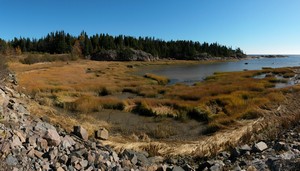 From Baie-Comeau, we're heading along The St Lawrence towards Montreal and are pleasantly surprised
by the shoreline. While this mighty waterway narrows southwards, at this stage it is more like an
open body of water; the other side too distant to be seen. The banks resemble a coastal shore with
cliffs, coves, bays and inlets; the bright sunshine bringing the autumnal colours to life.
From Baie-Comeau, we're heading along The St Lawrence towards Montreal and are pleasantly surprised
by the shoreline. While this mighty waterway narrows southwards, at this stage it is more like an
open body of water; the other side too distant to be seen. The banks resemble a coastal shore with
cliffs, coves, bays and inlets; the bright sunshine bringing the autumnal colours to life.
It is chilly in the cool breeze as we stop at a waterside park in Ragueneau. The golden grasses undulate
in the wind, the water calm in the two sheltered inlets on either side of a small promontory. Out in
the main body of the flow the water is choppy, breaking against the rocky bluffs of the headland.
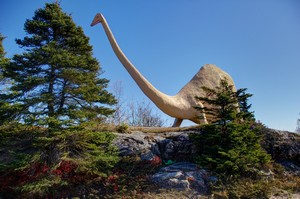 Looking out across the river is a brontosaurus. Admittedly it's only a replica but has been rendered
full-size and is somewhat unexpected. In spite of the colour difference, Sinclair is delighted and
poses for photographs with little encouragement, happy to be amongst his own.
Looking out across the river is a brontosaurus. Admittedly it's only a replica but has been rendered
full-size and is somewhat unexpected. In spite of the colour difference, Sinclair is delighted and
poses for photographs with little encouragement, happy to be amongst his own.
We drag him away, promising a visit to Dinosaur National Monument next year, and continue our journey.
There's a small ferry across the Le Fjord-du-Saguenay and we arrive in time to drive straight on.
One of the vehicles we share the deck with has a moose on their trailer. In case you're wondering,
it's dead. It is the height of hunting season and this careful display of the kill seems to be the
norm. We have also noticed moose heads exhibited, trophy style, in people's gardens. It is a very
different practice than in the States where game are usually covered with tarpaulins for transport
and heads are only displayed after the ministrations of a taxidermist. The Canadian approach seems
more down to earth and perhaps a little more gruesome.
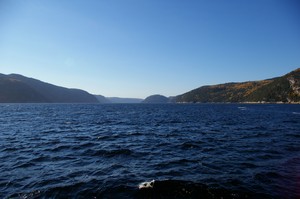
As the St Lawrence narrows we arrive in Baie-Saint-Paul where we plan to spend the night. We cruise looking for a likely spot and settle behind the ice arena where a game is in full flow, shouts and sounds of impact making it into the car park. When looking for somewhere to stop overnight in a town, we're often guided either by the presence of other RVs or by instinct. The latter was at play in this case but by the time we wake the following morning, three other rigs have joined us, our presence presumably taken as a sign that this was a safe location.
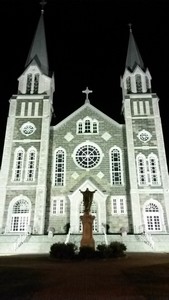 The small town is dominated by a huge church and an enormous convent, the Mother House of the Little
Franciscan Sisters of Mary but nowadays home to only a small number of nuns. Both buildings are
illuminated at night, their grandeur and size accentuated against the darkening sky. The quaint
town centre is bustling in the fading light of early evening, the shops, festooned in autumn
decorations, vying for the tourists with their art works, knicknacks and expensive clothing. We're
out for dinner and again resorting to our standard French phrases, learnt parrot fashion and
delivered in the outrageous accents mentioned in the last log. We survive and are well fed and
watered by the time we walk back to the camper, partly due to the bi-lingual waiter who finally
took pity on us, having first enjoyed the entertainment of our mangling of his first language.
The small town is dominated by a huge church and an enormous convent, the Mother House of the Little
Franciscan Sisters of Mary but nowadays home to only a small number of nuns. Both buildings are
illuminated at night, their grandeur and size accentuated against the darkening sky. The quaint
town centre is bustling in the fading light of early evening, the shops, festooned in autumn
decorations, vying for the tourists with their art works, knicknacks and expensive clothing. We're
out for dinner and again resorting to our standard French phrases, learnt parrot fashion and
delivered in the outrageous accents mentioned in the last log. We survive and are well fed and
watered by the time we walk back to the camper, partly due to the bi-lingual waiter who finally
took pity on us, having first enjoyed the entertainment of our mangling of his first language.
As we head for the border the next morning we are side tracked by the promise of cheese. A road sign advertising a Fromagerie has Sterling’s attention and he assures me it cannot be far to go. I have heard such assurances before! It turns out to be a fairly small place producing only a handful of varieties in small quantities. Having tasted everything on offer, we settle on a couple and declare the detour worth while. How could it not be, with cheese involved?
We cross the border back into the US and find ourselves in the archetypal New England state of Vermont. Distinctive churches clad in white siding, their steeples reaching skywards, form the nucleus of the small towns huddled amongst the deciduous woodland in its autumn finery. The countryside is gentle; hills, woods, lakes and farm land creating a tame yet pleasing tapestry.
The northwest section of the state is dominated by Lake Champlain, the expanse of water divided by a string of substantial islands along it’s length. Highway 2 follows the line, a number of bridges completing the connection, taking us down to Grand Isle State Park for a couple of nights.
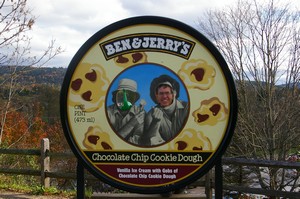 The highlight of our short time in Vermont is a visit to Ben & Jerry’s in Waterbury. We take the tour
and groan at the tour guide’s dairy related puns. The inside walls are decorated in the distinctive
artwork of clouds and cows found on the famous tubs, while outside is the original bus, painted in
similar motifs, in which the founders toured the country drumming up business in their early days.
The whole place is a real tourist trap but worth the visit, especially for the free sample. Initial
anticipation is momentarily dampened by the threat of Broccoli Cheddar Chunk but fortunately at the
last moment Strawberry Cheesecake materialises and is greeted with a collective sigh of relief. The
sample is enough to tantalise the taste buds and we head for the ice cream stand where there is a
huge selection of flavours on sale, many of which we’ve never seen before. Making a choice is a
difficult business but one that we get to grips with.
The highlight of our short time in Vermont is a visit to Ben & Jerry’s in Waterbury. We take the tour
and groan at the tour guide’s dairy related puns. The inside walls are decorated in the distinctive
artwork of clouds and cows found on the famous tubs, while outside is the original bus, painted in
similar motifs, in which the founders toured the country drumming up business in their early days.
The whole place is a real tourist trap but worth the visit, especially for the free sample. Initial
anticipation is momentarily dampened by the threat of Broccoli Cheddar Chunk but fortunately at the
last moment Strawberry Cheesecake materialises and is greeted with a collective sigh of relief. The
sample is enough to tantalise the taste buds and we head for the ice cream stand where there is a
huge selection of flavours on sale, many of which we’ve never seen before. Making a choice is a
difficult business but one that we get to grips with.
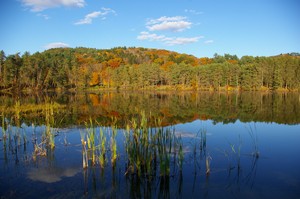 Our final destination in Vermont is at Quechee where our good impression of the state parks continues.
The park is on the edge of a small gorge, trails stretching from water level, up along the rim to an
old mill pond a short distance away. With pizza and beer in walking distance from the campground,
it’s another very satisfactory stop.
Our final destination in Vermont is at Quechee where our good impression of the state parks continues.
The park is on the edge of a small gorge, trails stretching from water level, up along the rim to an
old mill pond a short distance away. With pizza and beer in walking distance from the campground,
it’s another very satisfactory stop.
Autumn is picking up pace and we need to be going south but the temptation to see Niagara Falls gets the better of us as we head west into New York State.
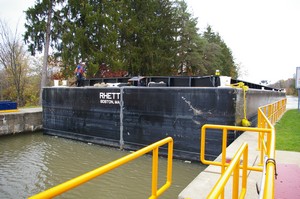 En route, we drive alongside the Champlain Canal and just outside Fort Edward, stop to see one of the
locks. The canal and consequently the locks are much wider than those in Britain, or Maine for that
matter, and there appears to be a lot of activity around this one. The friendly lock keeper tells
us that the river bed is being dredged, the large barges carrying the material being removed. The
aim is to clear PCBs contained in
the fine silt on the river bed, allegedly the pollutants from a GE
factory that used to be the main employer in the nearby town. GE is paying for the clean-up including
transportation of all the material to a PCB waste treatment plant in Texas.
En route, we drive alongside the Champlain Canal and just outside Fort Edward, stop to see one of the
locks. The canal and consequently the locks are much wider than those in Britain, or Maine for that
matter, and there appears to be a lot of activity around this one. The friendly lock keeper tells
us that the river bed is being dredged, the large barges carrying the material being removed. The
aim is to clear PCBs contained in
the fine silt on the river bed, allegedly the pollutants from a GE
factory that used to be the main employer in the nearby town. GE is paying for the clean-up including
transportation of all the material to a PCB waste treatment plant in Texas.
In spite of our urgency to be heading into warmer climes, we need to get some work done and stop at
Glimmerglass State Park for a few nights. The campground is virtually empty and apparently quiet,
that is until the geese start up. We cannot recall seeing a single Canada Goose in the land of their
naming and yet they are here in their hundreds, taking low sweeping flights over the camper at dawn,
honking loudly to ensure we are awake. It’s not the most tuneful of alarms.
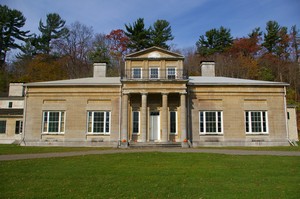
The park is located in what was the estate of Hyde Hall country mansion and the house still stands overlooking the water of Otsego Lake. The park is also home to the oldest surviving covered bridge in the US, built in 1823. Close by we gather walnuts off the ground. They are much smaller than the commercially grown varieties of today and are as tough as, well, nuts. Thankfully, the flesh is delightfully sweet, making the cracking and extraction worthwhile.
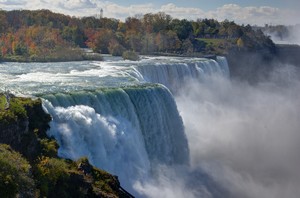 A few days later we’re heading for Niagara Falls. For those not familiar with the geography: the falls
are on the border with Canada, the twin towns on either side of the line bearing the same name as
each other and the mighty waterfall. The river in question, the Niagara, flows between Lakes Ontario
and Erie, its volume and pace worthy of these two great bodies of water. Just before it plummets down
the escarpment the river is divided by Goat island, the two channels creating the distinct and
separated American Falls and Horseshoe Falls.
A few days later we’re heading for Niagara Falls. For those not familiar with the geography: the falls
are on the border with Canada, the twin towns on either side of the line bearing the same name as
each other and the mighty waterfall. The river in question, the Niagara, flows between Lakes Ontario
and Erie, its volume and pace worthy of these two great bodies of water. Just before it plummets down
the escarpment the river is divided by Goat island, the two channels creating the distinct and
separated American Falls and Horseshoe Falls.
We intend to leave the camper in the State Park and walk from there. A plume of swirling mist rises
high into the sky as we approach, fine drops of water falling with increasing intensity. The roar,
as we step out of the truck, is unexpected and gives us some indication of the amount of water
involved.
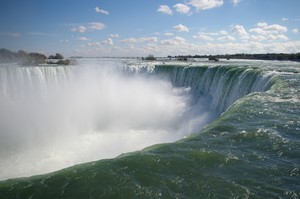 We make our way towards Terrapin Point situated at one end of Horseshoe Falls, and are promptly
soaked by wave after wave of spray. The water is absolutely mesmerising, the sense of smooth
uninterrupted movement and power captivating, the edge of the bedrock visible beneath the
overshooting clear greenish water. We can’t get the camera out but Sterling manages a few pictures
on his waterproof phone before we hurry away, slowly drying off in the weak sunshine. A pedestrian
bridge takes us from Goat Island across one arm of the Niagara. Beneath us, the river is wild;
churning, white water hurtling towards the edge.
We make our way towards Terrapin Point situated at one end of Horseshoe Falls, and are promptly
soaked by wave after wave of spray. The water is absolutely mesmerising, the sense of smooth
uninterrupted movement and power captivating, the edge of the bedrock visible beneath the
overshooting clear greenish water. We can’t get the camera out but Sterling manages a few pictures
on his waterproof phone before we hurry away, slowly drying off in the weak sunshine. A pedestrian
bridge takes us from Goat Island across one arm of the Niagara. Beneath us, the river is wild;
churning, white water hurtling towards the edge.
We walk across the Rainbow Bridge into Canada to see what turns out to be the best views of the
falls. This natural advantage may explain why the US side seems like the poor relation, the Canadian
side being better developed with uninterrupted vistas of both falls.
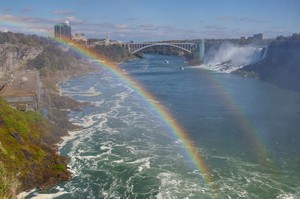 Having said that, both sides still represent tourist tack in the extreme but even this cannot detract
from the magnificence of the main attraction. There is no doubt that the falls would look even more
impressive without the surrounding buildings, bridges, light shows and other human interference but
at least the earlier attempts to “manage” the falls themselves have now been abandoned.
Having said that, both sides still represent tourist tack in the extreme but even this cannot detract
from the magnificence of the main attraction. There is no doubt that the falls would look even more
impressive without the surrounding buildings, bridges, light shows and other human interference but
at least the earlier attempts to “manage” the falls themselves have now been abandoned.
We come back into the States for the second time in as many weeks, get in the truck and head southwest for the winter, marking the end of our time in the northeast.